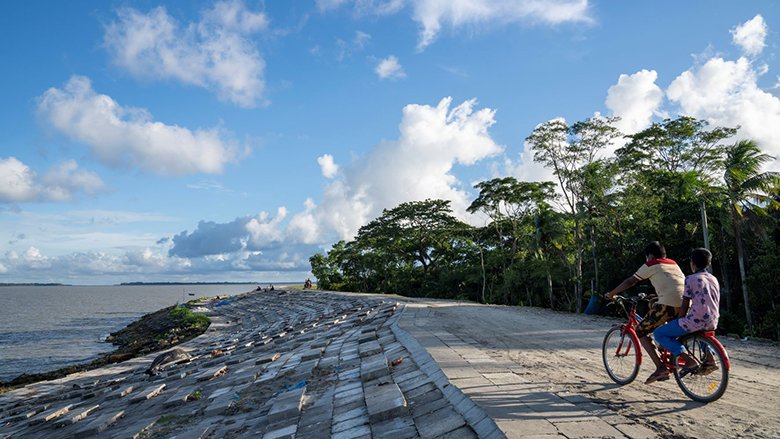Challenge
More than a quarter of Bangladesh’s population live in the country’s 580 km-wide coastal zone. It is an area in which a higher percentage of the people are below the absolute poverty line than any other region in the country. A World Bank study on the cost of adapting to extreme weather estimated that eight million people were vulnerable to inundation depths greater than three meters due to cyclonic storm surges. This number will increase to 13.5 million people by 2050, and an additional nine million are estimated to be affected because of climate change. There is an urgent need to rehabilitate and upgrade protection polders—areas of low-lying land—and enhance the resilience of coastal areas to cyclones, tidal and flood inundations, and salinity intrusion.
Approach
The Coastal Embankment Improvement Project (CEIP), was designed to support the rehabilitation and upgrading of the protection of polders to protect the coastal areas from tidal flooding and frequent storm surges and improve agricultural production by reducing saline water intrusion in selected polders using climate data and climate projections. When CEIP was approved in 2013 it was designed to improve 17 polders. In January 2020, the Project was restructured to reduce the scope from 17 to 10 polders due to financing constraints. The long-term objective of CEIP is to increase the resilience of the entire coastal population to tidal flooding and natural disasters by upgrading the whole embankment system. With an existing 6,000 km of embankments with 139 polders, the magnitude of such a project is enormous, necessitating a multi-phased approach to be adopted over a period of 15 to 20 years. CEIP-I is the first phase of this long-term program. The project will create a framework for polder design and an investment plan based on an understanding of the long-term and large-scale dynamics of the delta.
Results
The US$400 million CEIP has helped Bangladesh mitigate some of the large impacts of cyclones (Cyclone Titli 2018, Cyclone Bulbul 2019, Cyclone Fani 2019, Cyclone Amphan 2020, and Cyclone Yaas 2021) in the coastal region.
- The project has brought greater protection for 402,680 people, half of them women, with increased resilience to climate change from tidal flooding and storm surges in selected polders.
- As of December 2021, it has protected 41,661 ha and upgraded 249 km of embankments, constructed 115 hydraulic structures, and excavated 215.6 km of drainage channels.
- Agricultural productivity in the project sites has increased to 178.2% (Baseline 140%; end target 180%).
- With the formation of 141 water management groups and eight Water Management Associations, the community is overseeing the polders' overall operation and minimal upkeep during cyclones to ensure overall sustainability, including closing gates to avoid tidal flooding and salinity intrusion.
- The project’s afforestation program has covered 473.8 ha in 10 polders with 1,184,500 seedlings of local species.
The project design also includes in-depth analytics to better understand the complex dynamics of the delta and inform the Bangladesh government’s coastal resilience approach. This is a Technical Assistance component of around US$15 million, led by leading global experts for comprehensive data collection, state-of-the-art numerical modeling, and analysis to examine bank erosion, sediment processes, tidal river management, and the delta's long-term and large-scale morpho-dynamic behavior. Underlying data collection and analysis including socio-economic data are completed, as are all the models of the current situation. Modeling for future projections is in progress.
Bank Group Contribution
International Development Association (IDA) approved, in June 2013, funding in the amount of US$375 million.
Partners
- The Climate Investments Funds, under its Pilot Program for Climate Resilience, provides co-financing of US$25 million to the project’s IDA resource envelope.
- The Government of Netherlands gave grant-based technical assistance to review existing designs of riverbank protection and to provide recommendations for design optimization in close coordination with the Bangladesh Water Development Board and the World Bank.
- The Food and Agriculture Organization is providing technical support to the World Bank in supervising the cropping intensity and social afforestation activities under CEIP-I.
Moving Forward
CEIP-I is the first phase of a long-term program aiming to upgrade the entire coastal embankment system, consisting of 139 polders along 6,000 km of embankments. In CEIP-I, Bangladesh will rehabilitate 10 polders in its coastal embankment system, resulting in improved protection for over 724,000 people, including 362,000 women. Based on its success, a series of projects that benefit from the lessons CEIP-1 can potentially be designed for other coastal areas of Bangladesh.
Beneficiaries
Jaharul Sardar lives in Polder 32, which is vulnerable to tidal flooding and cyclone-induced storm surge. The land inside the polder is visibly lower than the shoreline outside it. But as he strolls barefoot along the freshly rebuilt embankment, he feels safe for now. "If we have good embankments and cyclone shelters,” he says, "We can survive."
